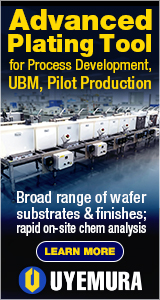|

|
|
| Ask the Experts | |||||||
|
|||||||
|
April 17, 2006 - Updated July 5, 2007 - Originally Posted Can PCB's designed for Sn/Pb be used in a Pb free assembly?We're a contract Mfg and customers are asking if FR4 PCB's that were designed for Sn/Pb can be used in a Pb free assembly? Some are double sided, some are multi-layer, lots have BGA's, some don't. We read conflicting opinion. Mike Johnson |
|||||||
| Expert Panel Responses | |||||||
|
General rules of thumb: No real design changes are required when moving from SnPb to Pb-free. Material changes may be required. Boards 62 mil and smaller thickness that can be reflowed at peak temperatures below 245C-250C, are acceptable with 150C Tg standard FR4. Peak temperatures tend to be driven by board dimensions (length x width) and size of the components. Once you get outside this range, options include going to 170C Tg or moving to some of the newer materials. Other issues drive this, including PTH aspect ratio and CAF susceptibility, but this is more complicated then a simple answer.
CEO & Managing Partner DfR Solutions Dr. Hillman's specialties include best practices in Design for Reliability, strategies for transitioning to Pb-free, supplier qualification, passive component technology and printed board failure mechanisms.
In many cases the initial Pb free builds of existing products were done using the then current board materials and designs, and in many cases these were successful, in that they produced a serviceable assembly within the reliability requirements of that product. However taking Sn/Pb technology into the Pb free process does have limitations and as reliability requirements change so will the suitability of the substrate. Increasing the reflow temperatures increases the tendency for delamination in multilayer boards can also lead to pad lifting in extreme cases. I have not personally had problems with second side print registration down to 0.65mm CSPs on regular FR4 but this certainly a possibility as reflow temperatures increase. The increased reflow temperature can induce increased warpage on some board materials which can impact second side printing registration if the board can not withstand the elevated temperatures.
Application Engineering Henkel Electronics Dr. Brian Toleno is the Application Engineering Team leader for Henkel Technologies. He is responsible for the technical service and application engineering for Henkel's electronics assembly materials, including solder paste, underfills, PCB protection materials, and underfills.
|
|||||||
| Submit A Comment | |||||||
|
Comments are reviewed prior to posting. You must include your full name to have your comments posted. We will not post your email address. |
|
Free Newsletter Subscription
Circuitnet is built for professionals who bear the responsibility of looking ahead, imagining the future, and preparing for it. Insert Your Email Address |
|

|




